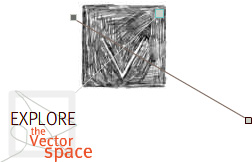Cast-offs from the Golden Age
Design by Erik Loyer
Designer's Statement
From the beginning, Melanie Swalwell was interested in making "Cast-offs from the Golden Age" an experience that would be eloquent of the ambiguities and loose ends of the research process. Ambiguity doesn't "just happen" in digital interactivity, however--it must be constructed out of well-defined structural elements which are fine enough in resolution to enable fluid recombination, yet coarse enough to signify recognizable ideas. The process, as a result, is thoroughly counter-intuitive with respect to its objective.
A project like "Cast-offs" is heavily database-driven for a number of reasons, the most important of which is the organic quality which a dynamic content storage medium lends the entire process. We aim to create original works for Vectors, not adaptations, and as such the writing (and rewriting) process must happen concurrently with the design and programming--a tight feedback loop between the three is essential if the final piece is to be truly responsive to the demands of the medium.
The database, of course, must be designed, and it can be a challenging process--essentially the task is to create a rough (very rough) analogue to the concepts and ideas a scholar has been developing over the course of many years. Furthermore, since in this case the process was being applied not just to a conceptual framework Melanie had developed, but to her own lived experience as a researcher, she had all the justification in world to reject the crude, rigid abstraction of life represented by the database design.
Fortunately, this proved not to be the case, and Melanie gamely threw herself into the formidable task of translating her experience and work into the rows, columns and relations of the database, enabled by our excellent data entry tools engineered by Craig Dietrich, tools which adapt instantly to changes in the structure of the database and greatly enhance the fluidity of our development process.
One of the joys of a project like this is reaching the point at which all the analysis and categorization involved in the design process gives way to the constructive and creative activities of experience-building. At some point one's fluency both with the tools and with the emerging characteristics of the system being built become subconscious to the point where the rightness or wrongness of a particular element can be intuited. Many thanks to Melanie and to all the scholars we work with for being open enough to an unfamiliar process to allow those moments to occur.
Further, I would like to thank Chad Corbin for making available his quaternion math ActionScript for 3D calculations, and my father, George Loyer, for helping me troubleshoot my modifications to the code.



